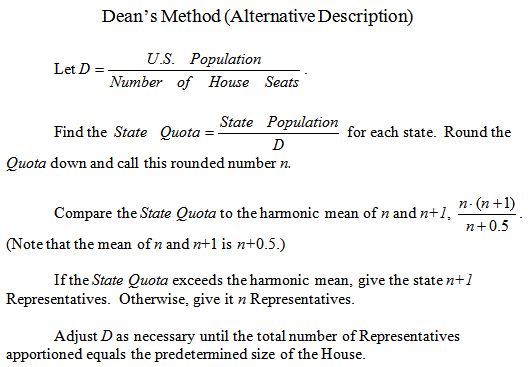- About MAA
- Membership
- MAA Publications
- Periodicals
- Blogs
- MAA Book Series
- MAA Press (an imprint of the AMS)
- MAA Notes
- MAA Reviews
- Mathematical Communication
- Information for Libraries
- Author Resources
- Advertise with MAA
- Meetings
- Competitions
- Programs
- Communities
- MAA Sections
- SIGMAA
- MAA Connect
- Students
- MAA Awards
- Awards Booklets
- Writing Awards
- Teaching Awards
- Service Awards
- Research Awards
- Lecture Awards
- Putnam Competition Individual and Team Winners
- D. E. Shaw Group AMC 8 Awards & Certificates
- Maryam Mirzakhani AMC 10 A Awards & Certificates
- Two Sigma AMC 10 B Awards & Certificates
- Jane Street AMC 12 A Awards & Certificates
- Akamai AMC 12 B Awards & Certificates
- High School Teachers
- News
You are here
Apportioning Representatives in the United States Congress - Dean's Method of Apportionment
While Adams was pursuing this new procedure, Senator Daniel Webster, also of Massachusetts, received a proposal from James Dean, a professor of Astronomy and Mathematics at Dartmouth College.
Although it may not appear this way at first glance, Dean’s method is equivalent to a method based on rounding. But in this case, the rounding is determined by the “harmonic mean:” the product of two numbers divided by their mean.
See the spreadsheet 1832 Dean for an illustration of this method. The file has two worksheets. The first shows just three states, New York, Maryland, and Louisiana. The left column is the potential number of Representatives for the state. The state’s population is divided by each potential number of Representatives, in turn, and compared to the given divisor (49,900 in this case). The number of Representatives assigned to that state is the number that minimizes the difference between the quotient and the divisor. The second worksheet illustrates the apportionment using the harmonic mean for all states. If you are interested in finding out more about the connection between Dean’s original description of the method and this rounding approach, download the Dean explanation.
Although its bias is not as strong as Adams’, Dean’s method does still tend to advantage the smaller states at the expense of the larger ones. Notice in the previous file that the large state of New York has its quota of 38.59 Representatives rounded down to 38 by Dean, while the small state of Louisiana had its quota of 3.46 rounded up to 4. As n increases in size, the harmonic mean increases toward n+0.5, so that for smaller states Dean allows a greater opportunity for rounding up than it does for the larger ones.
Michael J. Caulfield (Gannon University), "Apportioning Representatives in the United States Congress - Dean's Method of Apportionment," Convergence (November 2010), DOI:10.4169/loci003163






